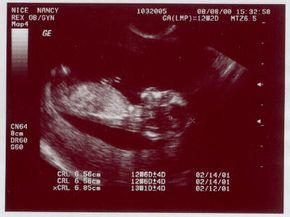What Is Ultrasound?
In ultrasound, the following events happen:
- The ultrasound machine transmits high-frequency (1 to 5 megahertz) sound pulses into your body using a probe.
- The sound waves travel into your body and hit a boundary between tissues (e.g. between fluid and soft tissue, soft tissue and bone).
- Some of the sound waves get reflected back to the probe, while some travel on further until they reach another boundary and get reflected.
- The reflected waves are picked up by the probe and relayed to the machine.
- The machine calculates the distance from the probe to the tissue or organ (boundaries) using the speed of sound in tissue (5,005 ft/s or1,540 m/s) and the time of each echo's return (usually on the order of millionths of a second).
- The machine displays the distances and intensities of the echoes on the screen, forming a two-dimensional image like the one shown below.
In a typical ultrasound, millions of pulses and echoes are sent and received each second. The probe can be moved along the surface of the body and angled to obtain various views.
Advertisement
